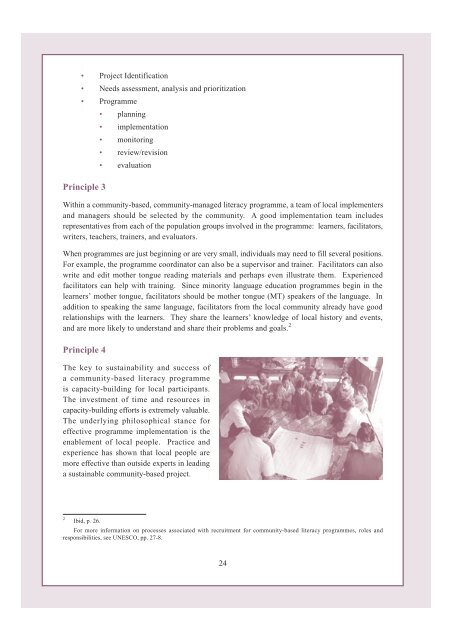Part I.pdf - MTB-MLE Network
Part I.pdf - MTB-MLE Network
Part I.pdf - MTB-MLE Network
Create successful ePaper yourself
Turn your PDF publications into a flip-book with our unique Google optimized e-Paper software.
• Project Identification• Needs assessment, analysis and prioritization• Programme• planning• implementation• monitoring• review/revision• evaluationPrinciple 3Within a community-based, community-managed literacy programme, a team of local implementersand managers should be selected by the community. A good implementation team includesrepresentatives from each of the population groups involved in the programme: learners, facilitators,writers, teachers, trainers, and evaluators.When programmes are just beginning or are very small, individuals may need to fill several positions.For example, the programme coordinator can also be a supervisor and trainer. Facilitators can alsowrite and edit mother tongue reading materials and perhaps even illustrate them. Experiencedfacilitators can help with training. Since minority language education programmes begin in thelearners’ mother tongue, facilitators should be mother tongue (MT) speakers of the language. Inaddition to speaking the same language, facilitators from the local community already have goodrelationships with the learners. They share the learners’ knowledge of local history and events,and are more likely to understand and share their problems and goals. 2Principle 4The key to sustainability and success ofa community-based literacy programmeis capacity-building for local participants.The investment of time and resources incapacity-building efforts is extremely valuable.The underlying philosophical stance foreffective programme implementation is theenablement of local people. Practice andexperience has shown that local people aremore effective than outside experts in leadinga sustainable community-based project.2Ibid, p. 26.For more information on processes associated with recruitment for community-based literacy programmes, roles andresponsibilities, see UNESCO, pp. 27-8.24
















